Introduction
1.1 Overview of Enterprise Software Projects
Within the realm of CodePaper’s expertise, enterprise software projects form the backbone of digital transformations for large organizations. These projects encompass the creation, deployment, and maintenance of software solutions tailored to the specific needs of clients. At CodePaper, we understand the intricate nature of these endeavors, involving collaboration across departments and addressing challenges at scale. The complexity of such projects necessitates a strategic and well-defined approach to software development.
Our focus on delivering innovative solutions that align with the unique requirements of each enterprise underscores the importance of a robust development methodology. As we delve into the role of Agile in this context, it’s crucial to recognize the significance of enterprise software projects in driving organizational efficiency and competitiveness.
1.2 Evolution of Software Development Methodologies
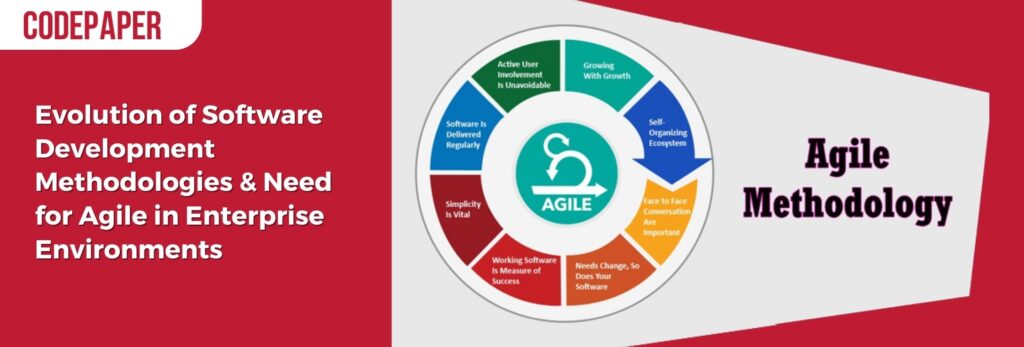
Codepaper’s journey aligns with the evolution of software development methodologies. Traditional models, like the Waterfall approach, once dominated the landscape, providing a structured but sequential framework. However, as the needs of businesses evolved, these models faced limitations in adapting to change and responding to dynamic market demands.
The transition to Agile methodologies marked a pivotal moment for Codepaper and the industry at large. Agile introduced an iterative, collaborative, and customer-centric approach that resonated with the principles of adaptability and continuous improvement. This shift became crucial in our pursuit of delivering software solutions that not only meet but exceed client expectations.
1.3 Need for Agile in Enterprise Environments
For Codepaper and its clients, the adoption of Agile methodologies was driven by the imperative for agility and responsiveness in the face of rapid technological advancements and changing business landscapes. The nature of enterprise environments demands a development approach that can accommodate evolving requirements and prioritize the delivery of incremental value.
Agile’s adaptive framework aligns seamlessly with CodePaper’s commitment to providing flexible and scalable solutions. In the context of enterprise software projects, where the stakes are high, and time-to-market is critical, Agile emerges as a catalyst for success. This need for agility in large-scale software development projects became the impetus for Codepaper to embrace and champion Agile methodologies, positioning us at the forefront of innovation in the industry.
Understanding Agile Development
2.1 Core Principles of Agile Manifesto

At Codepaper, our approach to software development is deeply rooted in the core principles of the Agile Manifesto. This foundational document places a premium on individuals and interactions, working solutions, and customer collaboration over processes and tools. By prioritizing these principles, Codepaper establishes a dynamic and client-centric environment that promotes adaptability and fosters a culture of continuous improvement.
The Agile Manifesto serves as a compass, guiding our teams to focus on delivering value iteratively, responding promptly to changing requirements, and ensuring client satisfaction throughout the development process. For Codepaper, embracing these principles means not just following a methodology but cultivating a mindset that places clients at the center of our development endeavors.
2.2 Agile Methodologies Overview
Codepaper recognizes the diverse landscape of Agile methodologies and leverages this versatility to tailor our approach to the unique needs of each project. Agile is not a one-size-fits-all solution, and understanding the nuances of each methodology allows us to craft development strategies that align with the specific challenges and objectives of our clients.
Within the CodePaper ecosystem, Agile methodologies serve as a toolkit, each with its distinct strengths. From the structured sprints of Scrum to the visual workflow management of Kanban, our teams strategically select and integrate these methodologies, ensuring a flexible, efficient, and client-focused development process.
2.2.1 Scrum
Scrum, a widely adopted Agile framework, plays a pivotal role in Codepaper’s development approach. It organizes our work into time-boxed iterations known as sprints, typically lasting two to four weeks. Daily stand-ups, sprint planning, and retrospectives are integral components of Scrum, fostering collaboration, transparency, and continuous improvement within Codepaper’s development teams.
Scrum’s emphasis on delivering a potentially shippable product increment at the end of each sprint aligns seamlessly with CodePaper’s commitment to providing clients with regular updates, tangible progress, and the flexibility to adapt to changing requirements swiftly. By adopting Scrum, CodePaper ensures that development efforts are not only efficient but also aligned with client expectations and market demands.
2.2.2 Kanban
Kanban, another valuable Agile methodology in CodePaper’s toolkit, revolves around visualizing workflow and minimizing work in progress. This approach is particularly effective for projects with evolving priorities and a continuous flow of tasks. CodePaper strategically employs Kanban to optimize workflow, providing clients with real-time visibility into project status and empowering our teams to make data-driven decisions for enhanced efficiency.
Kanban’s focus on visualizing the entire development process, limiting work in progress, and continuously improving workflow aligns seamlessly with CodePaper’s commitment to transparency, adaptability, and client satisfaction. By integrating Kanban into our development practices, CodePaper ensures that projects are delivered with maximum efficiency and responsiveness.
2.2.3 Extreme Programming (XP)
Extreme Programming (XP), with its emphasis on engineering practices, is an integral part of CodePaper’s commitment to delivering high-quality software solutions. XP principles, such as pair programming, continuous integration, and test-driven development, are embedded in our development process to ensure the creation of robust, maintainable, and scalable solutions.
Codepaper recognizes the importance of not only delivering software quickly but also ensuring its long-term viability. By incorporating XP practices, CodePaper’s development teams prioritize code quality, early and frequent testing, and collaborative coding efforts. This commitment to excellence aligns with CodePaper’s vision of providing clients with software solutions that not only meet immediate needs but also stand the test of time.
2.2.4 Lean
Lean principles, rooted in minimizing waste and maximizing value, guide CodePaper’s approach to software development. By eliminating non-value-added activities, CodePaper optimizes its development processes, delivering streamlined solutions that align with client objectives and market demands.
Lean principles are deeply embedded in CodePaper’s culture, influencing how we allocate resources, manage workflows, and deliver value to clients. By minimizing unnecessary steps, reducing delays, and continually improving processes, CodePaper ensures that each project is executed with efficiency and a focus on delivering maximum value to clients.
2.3 Agile vs. Traditional Waterfall Models
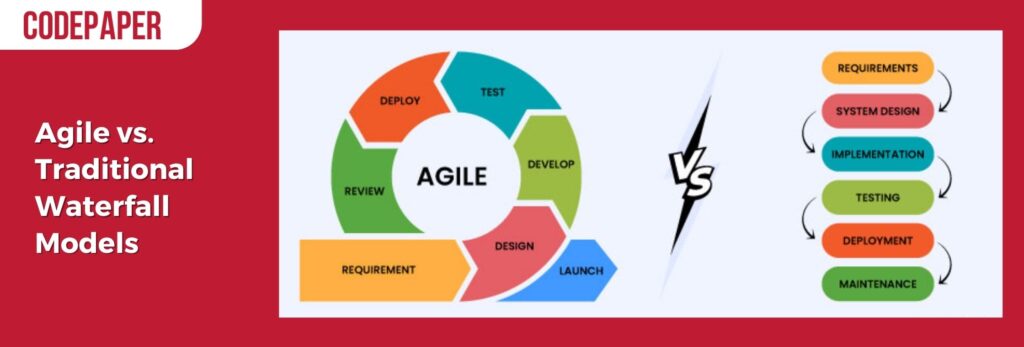
In the dynamic landscape of software development, the choice between Agile and traditional Waterfall models is a critical decision that shapes the development process. At CodePaper, our preference for Agile is driven by its inherent adaptability, client-centric approach, and ability to respond to evolving project requirements.
Aspect | Agile Methodologies | Traditional Waterfall Models |
Flexibility | Embraces change, allowing for iterative development. | Follows a rigid, sequential process, making changes challenging. |
Client Involvement | Encourages continuous client collaboration. | Involves clients primarily at the beginning and end of the project. |
Time-to-Market | Enables faster time-to-market through incremental releases. | Often results in longer development cycles. |
Approach to Change | Adapts to evolving project requirements. | Changes are difficult to accommodate once the development process begins. |
Feedback Integration | Incorporates continuous client feedback. | Limited opportunities for client input during development. |
Project Visibility | Provides real-time visibility into project status. | Progress updates may be limited until project completion. |
Risk Management | Mitigates risks through iterative development and adaptability. | Risks are identified and addressed in a sequential manner. |
Collaboration Emphasis | Fosters collaboration within cross-functional teams. | Collaboration is often siloed, with distinct phases for different teams. |
For CodePaper, the choice between Agile and traditional Waterfall models is a strategic decision that reflects our commitment to client success. Agile methodologies empower us to navigate the complexities of software development with agility, ensuring that our solutions are not only technologically robust but also aligned with the evolving needs of our clients.
III. Agile in the Enterprise Context
3.1 Characteristics of Enterprise Software Projects
- Multifaceted Requirements: Enterprise projects often involve multifaceted requirements that go beyond the scope of traditional software development. CodePaper acknowledges the need for solutions that can seamlessly adapt to these intricate demands.
- Interdepartmental Collaboration: Collaboration across various departments is a defining characteristic, requiring CodePaper to facilitate communication and integration among teams with diverse skill sets and responsibilities.
- Long-term Impact: Enterprise software solutions have a lasting impact on organizational operations. CodePaper understands the importance of building solutions that are not only effective in the short term but also sustainable and scalable for long-term growth.
- Integration Challenges: Integration with existing systems and technologies poses a significant challenge. CodePaper navigates through interoperability issues to ensure smooth integration, minimizing disruptions to ongoing business processes.
- Regulatory Dynamics: Compliance with ever-evolving industry regulations is a continuous concern. CodePaper stays abreast of regulatory dynamics to ensure that the developed solutions adhere to the latest standards and guidelines.
3.2 Challenges in Enterprise Software Development
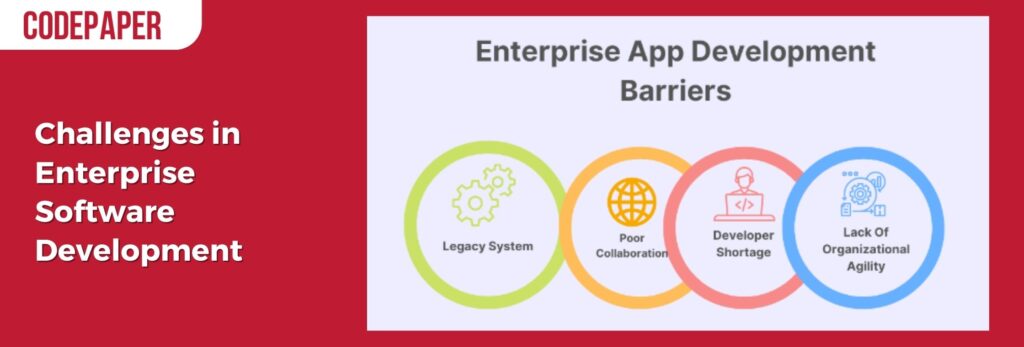
- Communication Silos: Communication silos between departments can lead to misunderstandings and delays. CodePaper focuses on breaking down these silos, fostering open communication channels to enhance collaboration.
- Resource Allocation: Effectively allocating resources across a large-scale project is a challenge. CodePaper employs strategic resource management to optimize productivity and ensure efficient use of available resources.
- Balancing Customization and Standardization: Striking the right balance between customization to meet specific needs and standardization for consistency is crucial. CodePaper tailors solutions to address unique requirements while maintaining a standardized approach where applicable.
- Legacy System Integration: Integrating new solutions with existing legacy systems poses integration challenges. CodePaper implements strategies to bridge the gap, ensuring a seamless transition and coexistence between old and new systems.
- Change Management: Large organizations often face resistance to change. CodePaper incorporates change management strategies to navigate organizational shifts and ensure a smooth adoption of new software solutions.
- Global Collaboration: Enterprises with a global presence require collaboration across geographically dispersed teams. CodePaper implements tools and processes that facilitate effective collaboration, overcoming geographical barriers.
- Scalability Concerns: Anticipating and addressing scalability concerns is crucial in enterprise projects. CodePaper develops solutions with scalability in mind, ensuring that they can grow alongside the organization’s expanding needs.
- Security at Scale: The scale of enterprise projects demands a robust approach to security. CodePaper implements comprehensive security measures, including encryption, access controls, and regular security audits, to safeguard sensitive data.
3.3 How Agile Addresses Enterprise Challenges
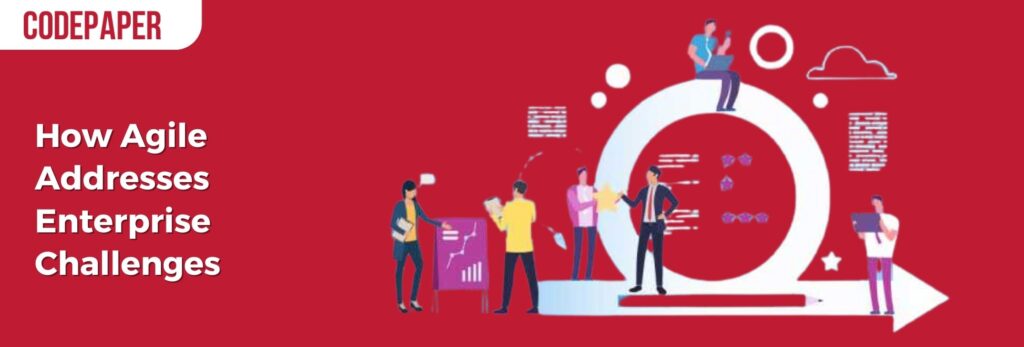
Agile emerges as a powerful solution to the challenges inherent in enterprise software development. CodePaper leverages Agile methodologies to enhance communication, collaboration, and adaptability within large organizations. The iterative nature of Agile allows CodePaper to address evolving requirements and dependencies dynamically.
In the enterprise context, Agile promotes cross-functional teams, enabling CodePaper to integrate diverse skill sets seamlessly. By breaking down development into manageable iterations, Agile ensures that progress is visible, and feedback loops are continuous. This approach, coupled with CodePaper’s commitment to client collaboration, mitigates challenges related to project visibility, stakeholder engagement, and managing complex workflows.
The principles of Agile, including customer satisfaction, collaboration, and responding to change, align closely with the goals of enterprise software development. CodePaper’s adoption of Agile in the enterprise context signifies not only a methodology shift but a strategic commitment to overcoming challenges and delivering value in an ever-evolving business landscape.
IV. Benefits of Agile in Enterprise Software Projects
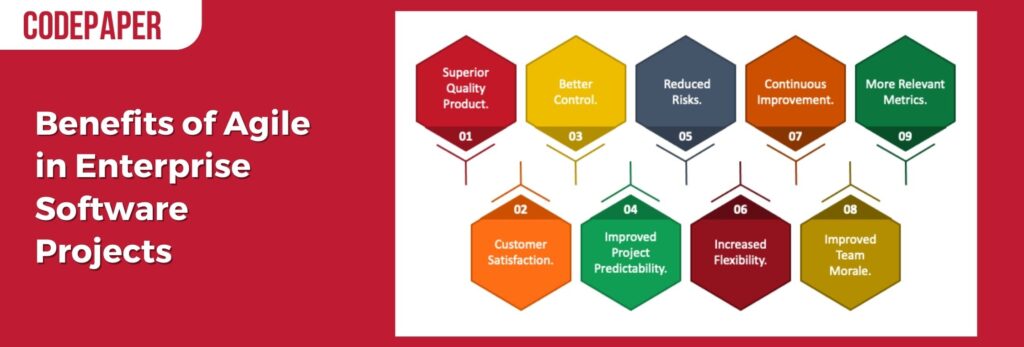
For CodePaper, adopting Agile methodologies in enterprise software projects yields a spectrum of advantages, aligning with our commitment to delivering innovative, high-quality solutions tailored to the dynamic needs of large organizations.
4.1 Flexibility and Adaptability
Agile’s foremost benefit for CodePaper in enterprise projects is the unparalleled flexibility it offers. Agile methodologies embrace change, allowing our teams to adapt swiftly to evolving requirements.
This flexibility is vital in the dynamic landscape of large organizations where shifts in priorities and business needs are frequent. CodePaper’s commitment to delivering solutions that can evolve with the client’s changing requirements aligns seamlessly with Agile’s emphasis on adaptability.
4.2 Faster Time-to-Market
Agile’s iterative development approach significantly accelerates the time-to-market for CodePaper’s solutions. By breaking down projects into manageable increments, we can deliver functional components in shorter cycles, ensuring that clients can realize value at a faster pace. This rapid delivery aligns with CodePaper’s dedication to providing timely and impactful solutions, giving clients a competitive edge in the ever-changing market.
4.3 Improved Collaboration and Communication
Agile methodologies prioritize collaboration and communication, fostering a culture of transparency within CodePaper’s development teams. Daily stand-ups, regular sprint reviews, and continuous client engagement ensure that everyone involved is well-informed and aligned.
This heightened level of collaboration not only streamlines the development process but also enhances CodePaper’s ability to understand and meet the specific needs of enterprise clients.
4.4 Enhanced Quality and Customer Satisfaction
Quality is a cornerstone of CodePaper’s development philosophy, and Agile methodologies reinforce this commitment. Through practices like test-driven development and continuous integration, CodePaper ensures that each increment is thoroughly tested and validated.
This dedication to quality not only reduces the likelihood of defects but also enhances customer satisfaction by delivering reliable and robust solutions. For CodePaper, customer satisfaction is not just a goal; it’s a measure of our success.
4.5 Risk Management in Agile
Agile’s iterative nature inherently supports effective risk management for CodePaper. By delivering solutions incrementally, potential risks are identified and addressed early in the development process.
This proactive approach allows CodePaper to mitigate risks swiftly, ensuring that the final product meets the client’s expectations and aligns with business goals. Agile’s emphasis on adaptability and continuous improvement is a strategic asset in navigating the uncertainties associated with large-scale enterprise projects.
V. Implementing Agile in Enterprise Settings

Implementing Agile in enterprise settings is a strategic initiative at CodePaper, focusing on fostering a collaborative culture, optimizing team structures, and leveraging scalable tools and technologies. This approach ensures that Agile methodologies seamlessly align with the unique dynamics and complexities of large-scale enterprise projects.
5.1 Building an Agile Culture
CodePaper recognizes that establishing an Agile culture is fundamental to successful implementation. It involves instilling Agile values and principles across the organization, emphasizing collaboration, adaptability, and continuous improvement. This cultural shift empowers teams to embrace change, prioritize customer satisfaction, and foster a mindset of flexibility and transparency in every aspect of the development process.
5.2 Agile Teams and Roles in Enterprises
In the enterprise context, CodePaper structures Agile teams strategically, ensuring the right mix of skills and expertise. Cross-functional teams, comprising individuals with diverse capabilities, promote efficient collaboration.
Roles are defined clearly, with an emphasis on collaboration over hierarchy. This Agile team structure enables CodePaper to navigate the complexities of large projects, ensuring each team member contributes meaningfully to project success.
5.3 Scaling Agile for Large Projects
Scaling Agile for large projects is a nuanced process at CodePaper. Adopting frameworks like SAFe (Scaled Agile Framework) or LeSS (Large Scale Scrum), CodePaper ensures that Agile principles are applied cohesively across multiple teams.
Scaling Agile involves synchronized planning, regular communication, and shared goals to maintain alignment across the organization. This approach allows CodePaper to harness the benefits of Agile while managing the intricacies of extensive enterprise initiatives.
5.4 Tools and Technologies for Agile Enterprise
Codepaper leverages cutting-edge tools and technologies to support Agile methodologies in enterprise settings. Project management tools like Jira, collaboration platforms like Confluence, and continuous integration tools ensure seamless workflow management and communication.
Codepaper’s use of these tools enhances visibility, facilitates collaboration, and streamlines development processes, ultimately contributing to the success of Agile implementation in enterprise projects.
For CodePaper, implementing Agile in enterprise settings is not just a methodology shift but a holistic approach that involves cultural transformation, strategic team structuring, and the integration of advanced tools and technologies.
This comprehensive strategy ensures that Agile principles are not only adopted but ingrained into the fabric of the organization, fostering a culture of innovation, collaboration, and client-focused development.
VI. Agile Best Practices for Enterprise Success
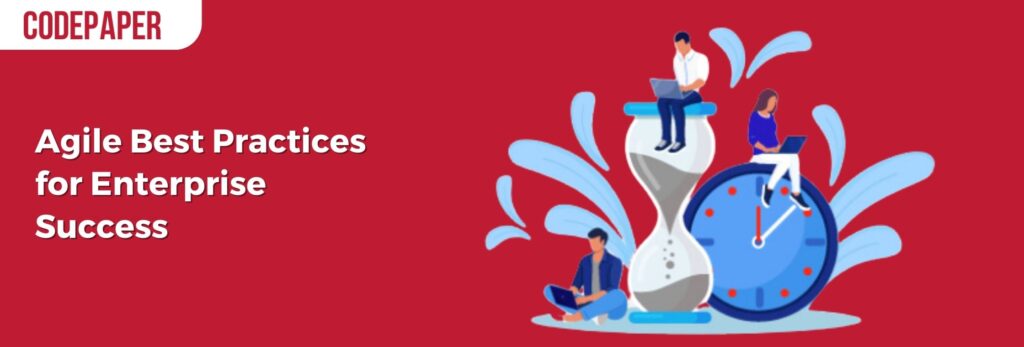
Agile best practices are integral to CodePaper’s approach, ensuring the success of enterprise projects by emphasizing continuous improvement, efficient deployment strategies, and proactive management of technical aspects.
6.1 Continuous Integration and Continuous Deployment (CI/CD)
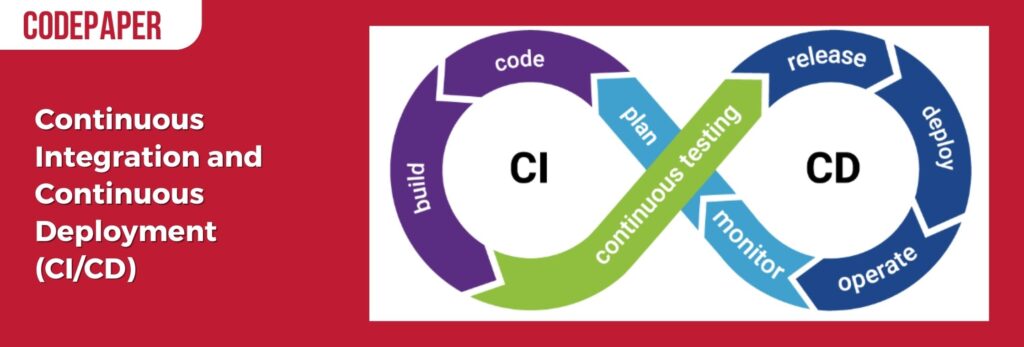
Codepaper prioritizes Continuous Integration (CI) and Continuous Deployment (CD) to streamline the development process. CI/CD pipelines automate testing and deployment, reducing manual errors and ensuring a consistent and reliable codebase. This practice aligns with CodePaper’s commitment to delivering high-quality software solutions efficiently.
7.2 Test-Driven Development (TDD)
Test-Driven Development (TDD) is a cornerstone at CodePaper, driving the creation of robust and reliable software. TDD involves writing tests before writing code, ensuring that each component meets its specifications. This practice not only enhances code quality but also provides a safety net for future changes. For CodePaper, TDD is a proactive approach to software development that aligns with our commitment to delivering high-quality solutions.
7.3 Retrospectives and Continuous Improvement
Retrospectives are a key component of CodePaper’s Agile best practices. These regular reflections on the development process allow teams to identify areas for improvement.
Codepaper fosters a culture of continuous improvement by encouraging open communication and implementing changes based on retrospective findings. This iterative feedback loop ensures that each project becomes an opportunity for learning and enhancement.
7.4 Managing Technical Debt in Agile

Managing technical debt is a critical best practice at CodePaper, ensuring the long-term maintainability of software solutions. CodePaper strategically addresses technical debt by balancing the need for rapid development with the importance of sustainable code.
This practice involves regular refactoring, prioritizing critical debt, and making informed decisions to maintain code health. CodePaper’s approach to technical debt aligns with our commitment to delivering solutions that stand the test of time.
VII. Agile Metrics and KPIs for Enterprise Projects

CodePaper places significant emphasis on Agile metrics and Key Performance Indicators (KPIs) to gauge project health, team performance, and the overall success of enterprise projects. These metrics provide valuable insights, enabling continuous improvement and informed decision-making throughout the development lifecycle.
7.1 Key Performance Indicators (KPIs) in Agile
- Cycle Time: CodePaper tracks cycle time to measure the time taken from task initiation to completion, providing insights into the efficiency of development processes.
- Lead Time: Lead time, another crucial KPI, helps CodePaper understand the overall time taken from the initiation of a feature to its delivery, offering a holistic view of project timelines.
- Sprint Velocity: Sprint velocity measures the amount of work a team can complete in a sprint, allowing CodePaper to estimate future work capacity and plan accordingly.
- Customer Satisfaction: Customer satisfaction KPIs, derived from feedback and reviews, reflect CodePaper’s commitment to delivering solutions that align with client expectations.
7.2 Measuring Team Velocity and Productivity
- Points Completed per Sprint: Codepaper tracks the number of story points completed per sprint to measure team velocity, providing insights into the team’s capacity and performance.
- Burndown Charts: Burndown charts visually represent the progress of work over time, allowing CodePaper to track how well the team is sticking to the sprint plan.
- Defect Rate: Codepaper measures the defect rate to assess the quality of deliverables, ensuring that each increment meets the highest standards.
- Code Churn: Code churn metrics provide insights into the frequency and extent of changes in the codebase, helping CodePaper manage development complexity and potential risks.
7.3 Burnup and Burndown Charts for Project Tracking
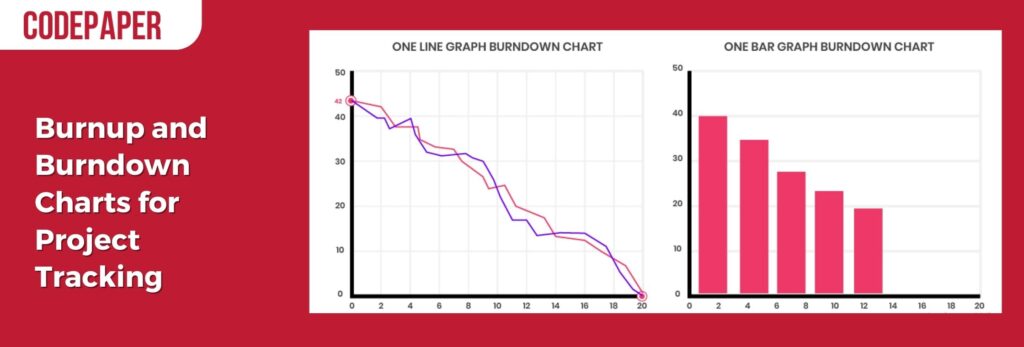
Burnup and burndown charts are essential tools for CodePaper in tracking project progress. Burndown charts illustrate the work completed against the planned work, offering a real-time snapshot of the team’s performance. Burnup charts, on the other hand, display the total work scope over time, providing stakeholders with a clear understanding of project evolution. These visual aids enhance transparency, facilitate informed decision-making, and contribute to the overall success of CodePaper’s Agile enterprise projects.
VIII. Future Trends in Agile for Enterprise
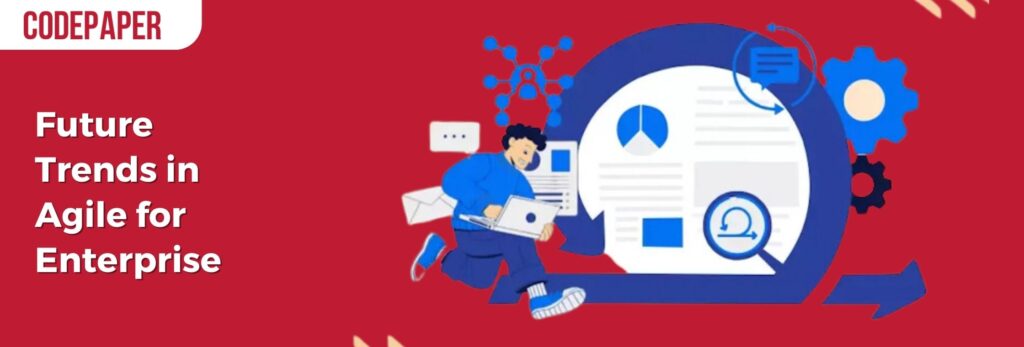
As CodePaper envisions the future of Agile in enterprise settings, several trends emerge that are poised to reshape the landscape of software development. These trends not only align with CodePaper’s commitment to innovation but also anticipate the evolving needs and challenges within the dynamic world of enterprise software projects.
8.1 Evolving Agile Practices
The future of Agile at CodePaper involves a continual evolution of practices to meet the demands of rapidly changing technologies and business environments. Agile methodologies are expected to adapt further, incorporating new techniques and frameworks that enhance collaboration, transparency, and the overall efficiency of development processes. As CodePaper embraces these evolving practices, the focus remains on delivering solutions that are not just current but future-proof.
8.2 Integration of DevOps with Agile

Codepaper recognizes the growing synergy between Agile and DevOps methodologies. The integration of DevOps with Agile practices is a future trend that aligns seamlessly with CodePaper’s commitment to streamlining development pipelines.
This integration facilitates continuous delivery, automated testing, and rapid deployment, enhancing the overall efficiency and reliability of software development processes. CodePaper envisions a future where Agile and DevOps converge to create a seamless and integrated approach to software delivery.
8.3 Artificial Intelligence and Agile
Artificial Intelligence (AI) is poised to play a significant role in the future of Agile at CodePaper. As AI technologies mature, their integration with Agile practices holds the potential to optimize decision-making processes, automate repetitive tasks, and enhance predictive analytics.
This synergy allows CodePaper to harness the power of AI in areas such as project planning, risk management, and quality assurance, contributing to more intelligent and data-driven Agile development.
8.4 The Role of Agile in Cloud-Native Development

Cloud-native development is emerging as a key trend that aligns with CodePaper’s vision for the future of Agile in enterprise projects. The scalability, flexibility, and accessibility offered by cloud-native architectures complement Agile principles, allowing for seamless integration of resources and services.
CodePaper envisions a future where Agile methodologies and cloud-native development converge to provide a dynamic and responsive environment, fostering innovation and accelerating time-to-market for software solutions.
For CodePaper, staying at the forefront of these future trends is not just a strategic choice but a commitment to providing clients with solutions that leverage the latest advancements in technology and methodology.
The future of Agile at CodePaper is one of continuous evolution, adaptability, and a relentless pursuit of excellence in the ever-evolving landscape of enterprise software development.
IX. Conclusion
As we conclude our exploration of Agile’s role in enterprise settings, Codepaper’s steadfast commitment to innovation and client-centric solutions takes center stage. The impact of Agile methodologies on enterprise software development at CodePaper has been transformative, revolutionizing project execution and empowering organizations to adeptly navigate the intricacies of the digital era.
9.1 Summarizing the Impact of Agile in Enterprise
Agile’s iterative and collaborative approach significantly enhances CodePaper’s adaptability, responsiveness, and overall delivery quality. Projects benefit from an accelerated time-to-market, ensuring a quicker response to market demands.
The impact extends beyond project outcomes; it permeates the organizational culture, fostering a mindset of continuous improvement and client-focused development. CodePaper has witnessed the positive influence of Agile in project outcomes and stakeholder satisfaction, reinforcing its strategic adoption.
9.2 Key Takeaways for Enterprise Software Development
Summarizing our exploration yields key takeaways crucial for CodePaper’s enterprise software development. Agile is more than a methodology; it’s a strategic choice aligning with the dynamic nature of technology and business landscapes.
The integration of DevOps, the strategic use of Artificial Intelligence (AI), and the convergence with cloud-native development represent future trends actively incorporated by CodePaper. The key takeaway is that Agile is not a static solution but a dynamic framework. CodePaper leverages Agile as a proactive strategy, delivering solutions that not only meet but exceed client expectations.
For CodePaper, Agile is not just a methodology—it’s a journey. It’s a commitment to excellence, adaptability, and continuous evolution. This commitment ensures that CodePaper delivers cutting-edge solutions, staying ahead in the dynamic landscape of enterprise software development. The journey with Agile at CodePaper is an ongoing pursuit of excellence and client satisfaction.

